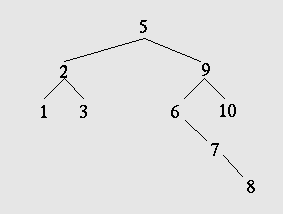- A structure that supports maintaining data in an order to facilitate
rapid searches.
- This tree must satisfy the binary search tree property
- Let x be a node in a binary search tree. If y is a node in the left subtree of x, then key[y] <= key[x]. If y is a node in the right subtree of x, then key[x] <= key[y]
- Build a binary search tree with keys 1, 4, 5, 10, 16, 17, 21 of
various heights.
- By maintaining this property we can implement the binary search
-
location Search(Tree T, element e)
- if T = NULL or e = key[T]
- return T
- if e < key[T]
- then return Search(T->left,e)
- else return Search(T->right,e)
- The performance of this algorithm is based on the height of the tree. O(h)
- The minimum can be located easily, just keep going left.
-
location Minimum(T)
- if T = NULL
- return T
- while T->left != NULL
- T = T->left;
- return T
- What would the algorithm for finding the maximum be?
- What is the performance of these algorithms?
- Finding the next node in the tree
-
location Successor(tree T)
- if T = NULL
- return T
- if T->right != NULL
- return Minimum(T->right)
- x = T
- y = T->parent
- while y!= NULL and x = y->right
- x = y
- y = y->parent
- return y
- The first part (lines 1-4) are clear, just the minimum right child if there is one.
-

- Consider the successor to 2, 5 or 9
- The second part, we just move up the tree until we find a parent with a different right child.
- Consider 1, 3, 8, 10
- What is the performance of this algorithm?
- Inserting
-
Insert(Tree T, element e)
- y = NULL
- x = T.root()
- while x != NULL
- y = x
- if key[e] < key[x->data]
- then x = x->left
- else x = x->right
- z = newnode
- z ->parent = y
- z -> left = NULL
- z -> right = NULL
- z -> data = e
- if y = NULL
- then T.root = z
- else if key[z->data] < key[y->data]
- then y->left = z
- else y->right = z
- Build a tree by inserting the following 5, 2, 9, 3, 1, 10, 6, 7, 8
- Deletion is a bit more tricky
- We need to maintain the binary search tree property
- If the node to be deleted is a leaf node, just delete it.
- If a node is not a leaf node, but only has one child, replace it with it's child.
- If a node has two children, then replace it with it's successor.
-
Delete(Tree T, location z)
- if z->left = NULL or z->right = NULL
- then y = z
- else y = Successor(z)
- if left[y] != NULL
- then x = left[y]
- else x = right[y]
- if x != NULL
- then x->parent = y->parent
- if y->parent = NULL
- then T.root = x
- else if y = y->parent->left
- then y->parent->left = x
- else y->parent->right = x
- if y != z
- then z->data = y ->data
- delete y
- In the previous diagram, delete 3
- Delete 5
- delete 6
- Not too bad, if we just didn't have the O(n) in the worst case.
